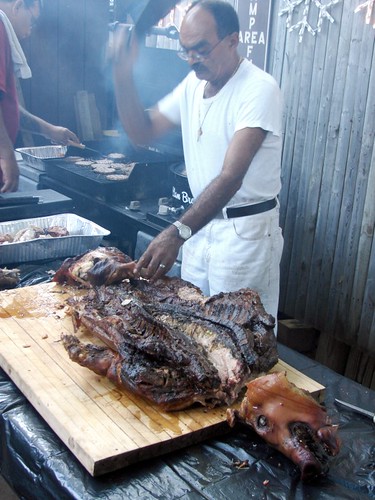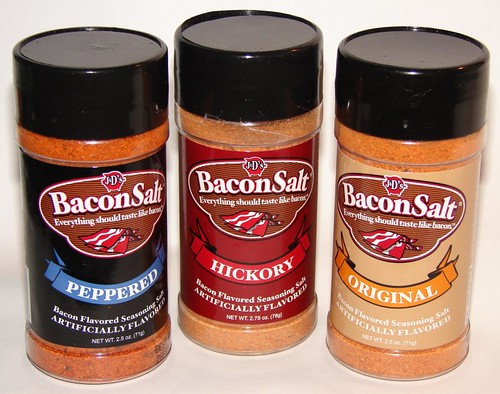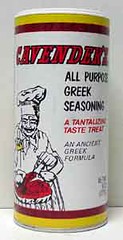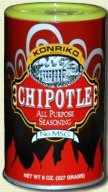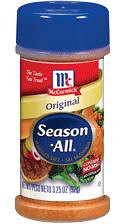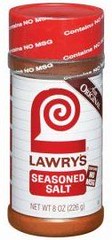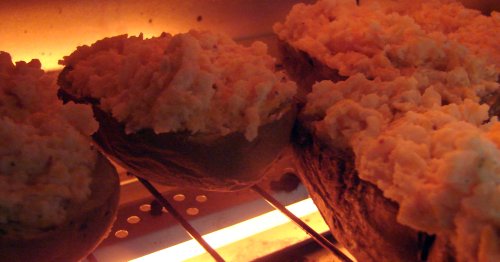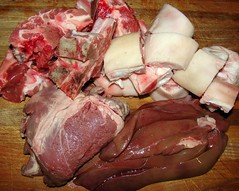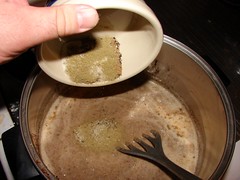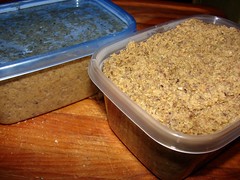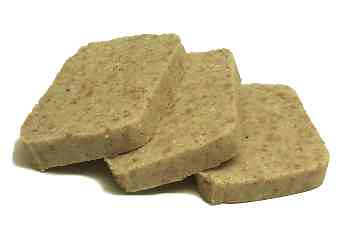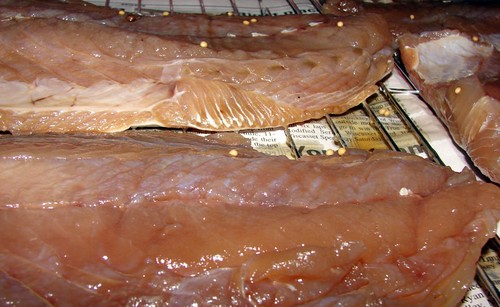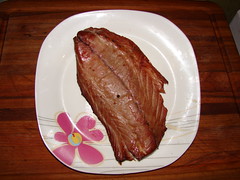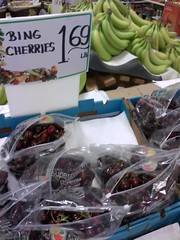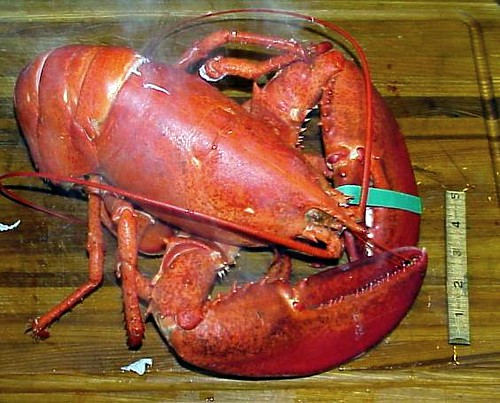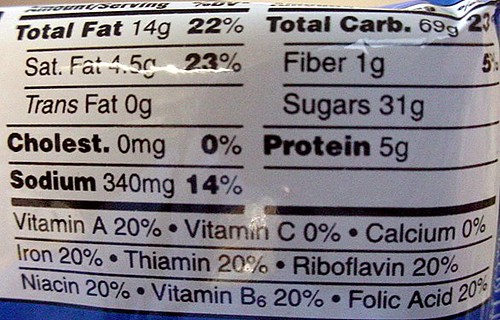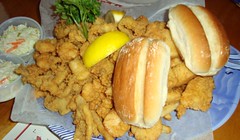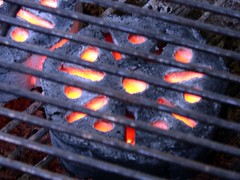
I just tried a so-called "miracle product" that is the most useless pile of shit I've ever bought for my grill: Lokkii brand BBQ Briquettes. They are individually-wrapped custom formed briquettes made of charcoal, anthracite, and an "ignition layer" which are supposed to provide up to 2 hours of heat per briquette; the package claims that two of them yield enough heat to barbecue a whole 2½-pound chicken in about 40 minutes.
They certainly are an intriguing item. Each briquette is about four inches in diameter and an inch tall with a spoke-like pattern of holes running through it. The top layer is the "ignition layer" and is a different composition than the rest of the briquette. Prepping the grill for cooking is easy: Just unwrap a couple of Lokkii briquettes, place them ignition-side up on the charcoal rack in the grill, light them, and let them burn up to cooking temperature (about 10 or 15 minutes.) Once lit, Lokkii claims that they'll provide heat for cooking for up to two hours, delivering 11,500 BTU per briquette.

The ignition is pretty fascinating. Touch a match to the center of the briquette, and it begins to burn brightly, quickly spreading to the entire top surface with a large and active flame that sparkles and hisses like burning gunpowder. The fire jumps at least eight inches high, and there's no need to individually light any briquettes that are close enough to touch the first one you fire, because the coating is very flammable and the fire will easily race to the next one. After a few minutes, the ignition phase is over and the briquettes settle down to their slow cooking burn. Within 10 to 15 minutes, the interior of the briquettes are glowing bright cherry-red and the grill is ready to use.
This is where the frustration starts.
To begin with, 11,500 BTU sounds pretty impressive when you're looking at a ventilated hockey puck made of charcoal. But when you spread that 11,500 BTU over a two-hour cooking time, you're looking at a cooking temperature of 350° F, (as noted on their own website) and that is frustratingly low when compared to lump charcoal or even decent-quality charcoal briquettes. Lokkii briquettes burn at such a low temperature that when I checked to see if they were ready for cooking, I was able to hold my hand an inch above the cooking rack without feeling any discomfort for several moments. I was dubious, but the inside of the briquettes were glowing brightly, so I continued the trial; I placed three average-sized split chicken breast portions directly over the briquettes, rib side down, in my Weber kettle grill.
Each breast portion was one-half of a chicken breast, skin on, and bone in (rib bones and half the breast bone,) about 10 to 12 ounces per portion, rinsed, patted dry, and seasoned but otherwise as taken from the package (no trimming, no pounding flat, no filleting, etc.) Normally when grilling split breasts I put lump charcoal in a strip down the center of the Weber and use the high but indirect heat to cook the chicken on either side of the fire, then I finish them up with a nice crispy browning on all sides directly over the heat. They are generally done in 20 - 25 minutes depending on the size of the portions, how much charcoal I've actually put in the grill, and how many of them I'm doing.
The Lokkii briquettes burn so much cooler than real charcoal that I placed the chicken direct above them. They took awhile to start cooking, but once the meat started to warm up and the fat in the skin started to render, cooking seemed to proceed nicely. There were very few flares, as the heat of the briquettes seemed to be near the center of them, and a cooler coal topping prevented excessive flame.
I checked the breasts frequently as they cooked over this unfamiliar medium, and they were finally ready to turn over in 15 minutes. I left them, skin-side down, to cook for another 15 minutes, but they were still quite underdone. Finally, after cooking them for a little over 45 minutes, they seemed ready. A temperature probe to the center of the breasts registered 160° F, which is just about right despite the panicky BS you might have read about making sure poultry is 180°.
Ah, but it turns out that the chicken was properly cooked only in the center. In the section close to the breastbone, the chicken was just barely turning translucent, and was very sashimi-like. Back out to the grill it went for an additional 15 minutes for a total cooking time of full hour. For split chicken breasts! Completely unacceptable.
In addition to their inabilty to cook properly, I have an issue with their price. The standard packaging available around here is a corrugated box containing two briquettes which retail for $3.99. Lokkii claims that two briquettes are equivalent to 5 pounds of charcoal; therefore, you would need to spend $16 on Lokkii briquettes equivalent to a 20-pound bag -
twice the cost of charcoal. Crappy performance at double the price.
Lokkii makes a big deal about their "patent pending" ignition system which is not reliant upon "petrochemicals" or "harmful ignition fluids." I use a charcoal chimney that I ignite with newspapers or fatwood sticks. No petrochemicals or harmful ignition fluids there, either. And despite whatever claims Lokkii might make about "environmental friendliness," their briquettes contain anthracite coal, which is not carbon-neutral. Pure lump charcoal is a better choice for anyone actually monitoring their carbon footprint.
But they cross the line from "marketing hype" to "liars who are full of shit" when they make this claim on their website:
"Greenhouse friendly: No Harmful Petro Emissions or Chemical emissions are released in the atmosphere." They also claim their briquettes are
"non toxic." Dream on. Made of charcoal and anthracite,
burning the briquettes is guaranteed to release carbon monoxide into the air, and these are no safer nor less toxic than burning any other kind of charcoal. I should also note that Lokkii briquettes carry the logo of the National Barbecue Association on their label and claim that they have been "endorsed by the NBBQ." Visiting the NBBQ's website reveals that they are a trade association concerned primarily with promoting barbecuing-related industries, not with furthering any actual culinary arts. The certification is as much a worthless gimmick as the product itself.
Bottom line: Lokkii briquettes are an expensive, poor-quality product which will not make your grilling experience better, cleaner, less toxic, or more enjoyable.
Update (1 Sept 2008):
I'm turning off additional comments for this entry. Apparently, there are a number of people out there who think that because I don't like this product, I must be an employee of a charcoal company. I'm not. Every product I review in this blog is a product I have purchased at a retail outlet. I don't get paid to post, and I'm not in anyone's pocket, and quite frankly if you get this butthurt over my dislike one of your favorite shitpiles, you can take your issues, stick them up your ass, and click on someone else's blog.
 My daughter Lynn enjoys cooking and trying new things. Not long ago, she found a recipe for a raspberry mousse on Nicole Weston's old blog bakingsheet and decided it would be a delicious late-summer dessert.
My daughter Lynn enjoys cooking and trying new things. Not long ago, she found a recipe for a raspberry mousse on Nicole Weston's old blog bakingsheet and decided it would be a delicious late-summer dessert.

